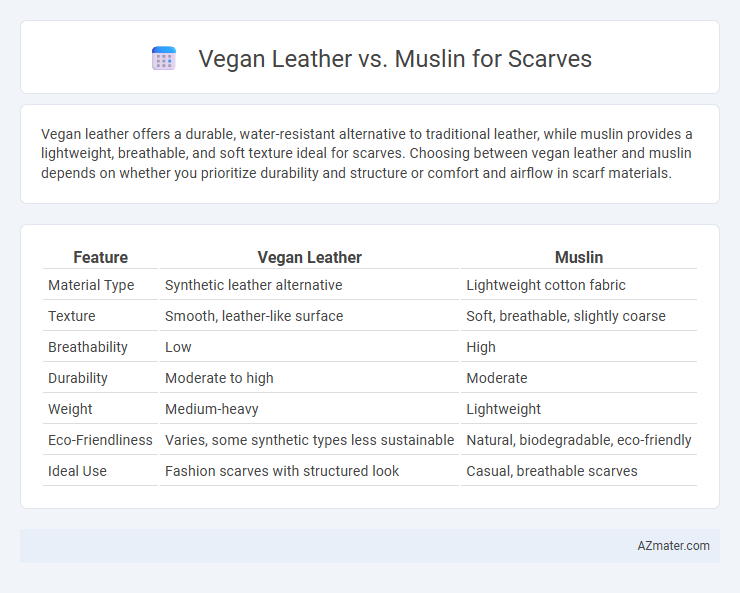Vegan leather offers a durable, water-resistant alternative to traditional leather, while muslin provides a lightweight, breathable, and soft texture ideal for scarves. Choosing between vegan leather and muslin depends on whether you prioritize durability and structure or comfort and airflow in scarf materials.
Table of Comparison
| Feature | Vegan Leather | Muslin |
|---|---|---|
| Material Type | Synthetic leather alternative | Lightweight cotton fabric |
| Texture | Smooth, leather-like surface | Soft, breathable, slightly coarse |
| Breathability | Low | High |
| Durability | Moderate to high | Moderate |
| Weight | Medium-heavy | Lightweight |
| Eco-Friendliness | Varies, some synthetic types less sustainable | Natural, biodegradable, eco-friendly |
| Ideal Use | Fashion scarves with structured look | Casual, breathable scarves |
Introduction: Understanding Vegan Leather and Muslin
Vegan leather, a synthetic alternative to traditional leather, offers a cruelty-free and sustainable option often made from polyurethane or plant-based materials like cactus or pineapple fibers. Muslin, a lightweight and breathable cotton fabric, is prized for its softness and versatility in scarves, providing a natural, eco-friendly choice. Understanding the distinct textures, environmental impacts, and durability of vegan leather versus muslin helps consumers select scarves that align with their ethical values and style preferences.
Material Origins: Vegan Leather vs Muslin
Vegan leather, made from synthetic materials like polyurethane or plant-based alternatives such as pineapple leaves and cork, offers a cruelty-free option derived from innovative textile technology. Muslin is a lightweight, plain-woven cotton fabric originating from South Asia, known for its natural fiber composition and breathable texture. While vegan leather emphasizes sustainability through animal-free production methods, muslin prioritizes organic cotton cultivation and traditional weaving processes.
Environmental Impact Analysis
Vegan leather production involves synthetic materials like polyurethane and PVC that release microplastics and contribute to non-biodegradable waste, significantly impacting the environment. Muslin, made from natural cotton fibers, offers a biodegradable alternative with lower carbon emissions but requires substantial water and pesticide use in cultivation. Choosing muslin for scarves reduces reliance on fossil fuels and synthetic chemicals, promoting a more sustainable textile cycle despite its agricultural drawbacks.
Breathability and Comfort for Scarves
Muslin fabric offers superior breathability and comfort compared to vegan leather, making it ideal for scarves worn in various climates. Its lightweight and loosely woven texture allows better air circulation, preventing overheating and skin irritation. In contrast, vegan leather tends to be less breathable, often causing discomfort and moisture buildup during extended wear.
Durability and Longevity Compared
Vegan leather offers moderate durability with resistance to water and stains but may crack or peel over time, limiting its longevity in scarves. Muslin, a lightweight cotton fabric, provides excellent breathability and softness but tends to be less durable, prone to wear and tear after frequent use. When comparing durability and longevity for scarves, vegan leather generally lasts longer under regular handling, while muslin requires gentler care to maintain its fabric quality over time.
Style Versatility and Aesthetic Appeal
Vegan leather scarves offer a sleek, modern aesthetic with a smooth texture that complements contemporary and edgy fashion styles. Muslin scarves provide lightweight breathability and a soft, natural drape, enhancing bohemian and casual looks with their subtle texture and earthy appeal. Both materials excel in style versatility, allowing easy pairing with diverse outfits, yet vegan leather tends to create a statement piece, whereas muslin emphasizes comfort and understated elegance.
Ethical Considerations in Fabric Choice
Vegan leather offers a cruelty-free alternative to animal hides, aligning with ethical concerns about animal welfare and reducing environmental impact compared to traditional leather production. Muslin, made from natural cotton fibers, provides a biodegradable and sustainable option with minimal chemical processing, supporting eco-friendly fashion choices. Choosing between vegan leather and muslin for a scarf depends on prioritizing either animal-free materials or organic, renewable textiles with low ecological footprints.
Maintenance and Care Tips
Vegan leather scarves require gentle cleaning with a damp cloth and occasional use of mild soap to prevent cracking and maintain their smooth texture. Muslin scarves, made from lightweight cotton, are best cared for by hand washing in cold water and air drying to preserve their softness and prevent shrinkage. Both materials benefit from avoiding direct sunlight during drying to retain color vibrancy and fabric integrity.
Price Point and Accessibility
Vegan leather scarves generally come at a higher price point due to the cost of synthetic materials and manufacturing processes, making them less accessible for budget-conscious consumers. Muslin scarves are more affordable and widely available, thanks to the natural cotton fabric and simpler production methods. This price difference makes muslin a preferred choice for those seeking an economical and easily accessible scarf option.
Which is Better for Scarves? Final Verdict
Muslin offers exceptional breathability and softness, making it ideal for lightweight, summer scarves, while vegan leather provides durability and a sleek, modern aesthetic suited for statement pieces or cold-weather wear. The choice depends on the scarf's intended use: muslin excels in comfort and natural texture, whereas vegan leather stands out for structural integrity and water resistance. For everyday scarves prioritizing comfort and versatility, muslin is better, but for fashion-forward, durable scarves, vegan leather is the superior option.

Infographic: Vegan leather vs Muslin for Scarf
 azmater.com
azmater.com